Benchmark Media Systems made its reputation in both pro audio and audiophile circles by designing gear with extraordinarily low noise and distortion, and selling it at reasonable prices. When I reviewed Benchmark’s AHB2 stereo power amp (read my review), I was so impressed by its silent background, precise imaging, and the lack of treble tizz that I bought the review pair. Benchmark says the ideal mate for the AHB2 is their LA4 preamplifier. It’s another piece of Benchmark equipment with outstanding objective performance, and it’s the subject of this review.
The Benchmark LA4 Line Amplifier ($2,950 or $3,050 with remote) is a compact, analog line-level preamplifier, offering two balanced (XLR) and two single-ended (RCA) stereo inputs, balanced and single-ended stereo outputs, and one mono (summed) balanced output. The LA4’s front-panel controls, operated through a power button, a color touchscreen and a rotary volume control, include source selection, volume, balance, muting, and a useful −20 dB volume cut as a muting alternative. An optional remote works with both the LA4 and a connected Benchmark DAC2 or DAC3. Can the LA4 preamp provide the same sonic excellence as Benchmark’s amplifier? Let’s explore that question …
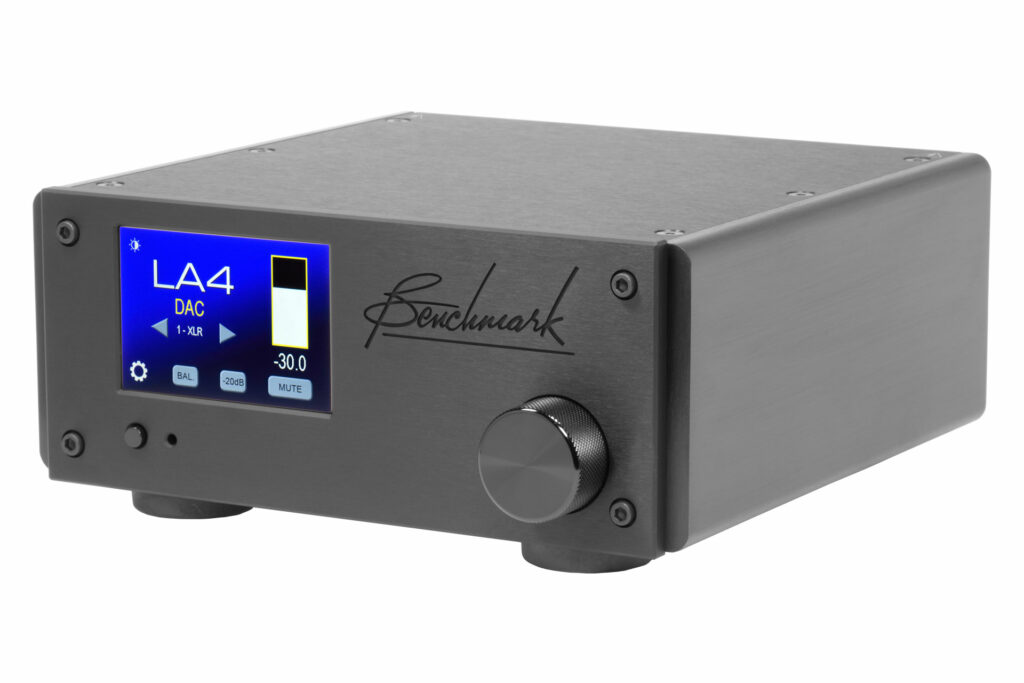
What Makes the Benchmark LA4 Preamp So Special?
- A high-quality volume control is much of what makes a superior preamp shine, and the Benchmark’s volume control is outstanding. The Benchmark LA4 uses a bank of precision resistors switched by gold-contact relays to set volume in 256 steps of 0.5 decibels each. This arrangement provides precise control of volume and channel balance, while avoiding the potential noise, distortion, and tracking error of potentiometers.
- Source selection and muting also are accomplished by relays, avoiding any sonic artifacts from mechanical switches.
- The Benchmark LA4 preamp offers outstanding, reported performance specs. These include frequency response of -0.003 dB at 10 Hz and -0.001 dB at 20 kHz, with -3 dB bandwidth from 0.1 Hz to 200 kHz; total harmonic distortion (THD) of less than 0.00006 percent (-125 dB); A-weighted signal to noise ratio (SNR) greater than 137 dB; and inter-channel crosstalk of -133 dB at 1 kHz. These specs far surpass those of most preamps and place any artifacts way below the -100 dB threshold often assumed for audibility.
- Its high (professional audio-inspired) maximum output allows the LA4 to drive low-gain power amplifiers, for lowest overall system noise. Still, the Benchmark LA4 is quiet at lower output levels, too, so its remarkably clean performance can be had with just about any audiophile power amp.
- Setup by touchscreen is useful and simple. Each input can be assigned a custom name or be disabled if not being used. There are settings for input level offsets, screen dimming, function locking, and more.
- Benchmark’s bidirectional 12-volt trigger jacks (two provided) allow the LA4 to turn other equipment on or off, or to be controlled by that equipment.
- The Benchmark LA4 is a physically compact stereo preamp. Its small case (approximately 8.7 inches wide by 3.9 inches high by 9.3 inches deep, including knobs, feet, and connectors) makes it about half the width of full-sized audiophile components. That and its light weight (eight pounds) allow the LA4 to fit into crowded equipment racks or desktop systems with limited space. I for one am a fan of the modern trend towards lighter, smaller audio equipment.
- An auto-ranging power supply accepts power at 50-60 Hz and 100-120 or 220-240 volts.With no user adjustments, it’s ideal for worry-free international travel, as you can’t blow up the power supply by forgetting to flip a switch. The preamp also has extensive protection circuitry against short circuits, overvoltage, and similar conditions.
- The Benchmark LA4 preamp is designed, fabricated, and tested by Benchmark Media in the United States. The LA4 comes with a full user’s manual and (in the U.S.A.) a generous five-year warranty.
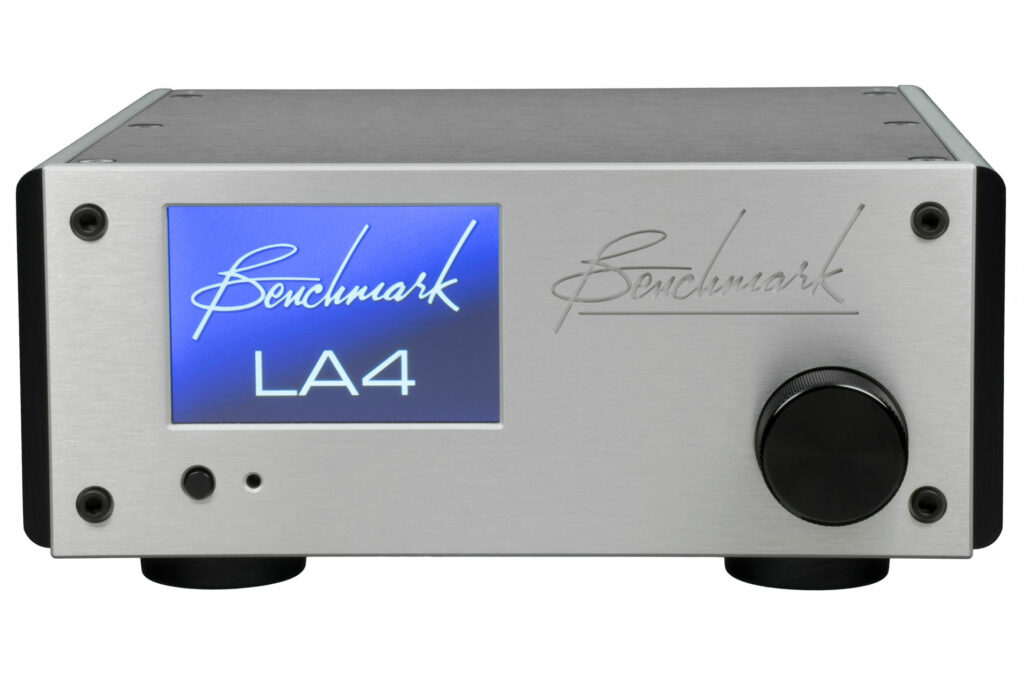
Why Should You Care About the Benchmark LA4 Preamplifier?
Many audiophiles want sound that’s enjoyable and also as faithful as possible to the source. (Isn’t that what high fidelity means?) If accurate reproduction is your wish, you won’t find a preamp with meaningfully better objective performance than the Benchmark LA4, especially one made in the United States at anything near the LA4’s price. Very few preamps at any price reach the LA4’s level of objective performance.
On the subjective end of things, the Benchmark LA4 preamp puts the lie to the old audiophile myth that neutrality means clinical, cold, or sterile sound. Instead, here neutrality means musical, involving sound, with precise, stable imaging, a sense of space (if one is on the recording), and exceptionally truthful timbres. (This was brought up by my listening panel, who were impressed at how engaging the sound was.) Classical music lovers will appreciate the timbral accuracy, as will anyone who knows the sound of a guitar, piano, violin, human voice, or brushes on a cymbal. The audience for the Benchmark LA4, then, is the audiophile who wants to hear the music on each recording presented in ultra-clean sound that is simultaneously truthful and engaging.
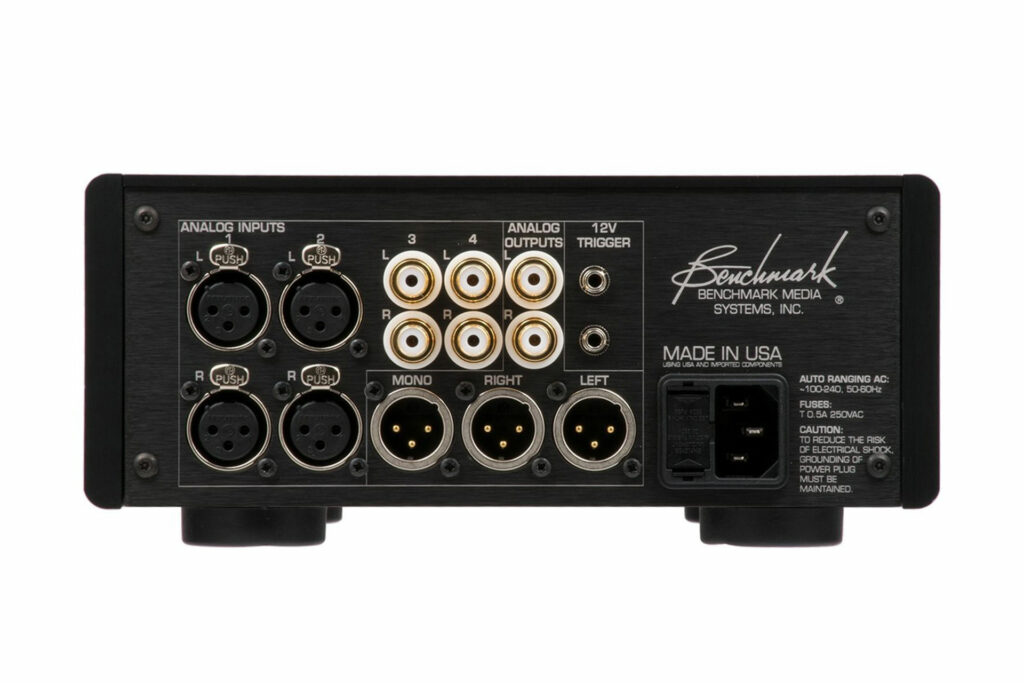
Some Things You Might Not Like About the Benchmark LA4 Preamp
- Benchmark’s industrial design is functional but unremarkable. The buyer of Benchmark gear is not paying for audio jewelry. The LA4 is a professional-class instrument and looks the part. Its simple front panel, which goes well with other Benchmark gear, holds a touchscreen that is legible and businesslike, but hardly fancy or elegant. Many audiophiles will decide that the LA4’s outstanding sound is far more important than its rather plain interface.
- The remote is limited. Its non-illuminated buttons, all the same color and size and arranged in a grid, make the remote’s use in dim lighting a bit tricky. (The Benchmark AHB2 amplifier’s protection circuitry saved me when, in the dark, I held down volume up on the remote instead of volume down.) The sturdy remote offers volume and source selection; balance control and setup are available only via the touchscreen.
- The Benchmark LA4 is strictly an analog linestage that competes on sound, not features. There’s no phono preamp, internal DAC, tone controls, processor loop to connect a recorder or equalizer, or similar features. To connect subwoofers, you can use the XLR and RCA outputs simultaneously, though that will rely on the subs’ low-pass filters and won’t high-pass the main speakers, as many prefer. Mono output is available only through a dedicated mono output, so you can’t switch mono mode on and off on the fly. What the LA4 does give you is the cleanest sound I’ve heard, and that’s a winning proposition for many audiophiles. Leaving other potential system building blocks up to you arguably gives an audiophile the widest range of possibilities and strongest protection against obsolescence. For example, the LA4 works exceptionally well with the Benchmark DAC3B, but an audiophile can use their preferred DAC instead.
- Nothing is added, nothing is taken away from the sound of the Benchmark LA4 stereo preamp. Every audiophile has their own wishes for a preamp. If they include a little added warmth or a subtle roll-off of high frequencies (which often are recorded too hot), the Benchmark LA4 will not be their cup of tea. Its mission is to pass through what’s on the recording, not to sweeten it in any way.
Listening to the Benchmark LA4 Preamplifier …
Benchmark sent their DAC3 B ($1,899 read Jerry Del Colliano’s review) to use with the LA4, so my reference preamp and its internal DAC were completely out of the picture. (The DAC3B is the simplest of Benchmark’s DAC3 series, but it has the same DAC circuitry as the others.) Therefore, my listening impressions are based on both Benchmark products used together, using only Benchmark interconnects, and feeding Benchmark power amplifiers.
I did not connect my subwoofers, nor did the system’s bass have the benefit of the room correction I usually employ. Towards the end of the review period, I applied some low-frequency PEQ through Roon, which removed much of the room boom while not doing obvious harm to the sound.
First up was Ry Cooder, in 2003 named number eight on Rolling Stone’s list of the 100 greatest guitarists of all time. Listening to Cooder’s version of “Goodnight Irene” from the album Live in San Francisco, I noted imaging and soundstaging the best I’ve yet heard them. Instrumental and vocal timbres were spot-on, and silent backgrounds increased the music’s clarity without any sense of artificial enhancement. The Benchmark LA4 brought out the subtleties in Cooder’s voice and in each instrument on the song, and that helped me make a better connection to the music. After Cooder’s tender, masterful guitar solo, accordionist Flaco Jiménez lets out a spontaneous whistle of appreciation. I was right there with him.
Music lovers of all tastes have found pleasure in the meditative compositions of Estonian composer Arvo Pärt. I listened to the duet “Spiegel im Spiegel [Mirror(s) in the Mirror],” played by violinist Vadim Gluzman and pianist Angela Yoffe on BIS CD 1434. This calm, gorgeous piece has been featured in many movie scores. As often with BIS and recording engineer Ingo Petry, the sound is clean and natural. As I listened through the LA4, I found the violin timbre more palpable and less electronic than I’d heard it before. Sometimes, when I listen to recorded violin, my shoulders go up, anticipating harshness in the high-frequency sound. This time, my shoulders stayed where they belong, and there was not the slightest trace of harshness to be heard. The piano sound, too, was clean and all of a piece, from the lowest bass notes through the treble.
Singer/songwriter Patsy Cline was loved and influential in both pop and country music of the last century. Her version of Willie Nelson’s “Crazy” (from the compilation album Icon) is a classic I often use to hear how components present older recordings. With the Benchmark LA4 in the setup, and despite the faded and somewhat artificial sound of this track, I got a clear picture of the beauty and range of Cline’s voice. Vocal textures and inflections were as detailed and natural as anyone could wish. Even the tape pre-echo of the final “you” was remarkably clear, and although that is musically unimportant, it showed yet again that the LA4’s transparency is simply outstanding.
Will the Benchmark LA4 Preamp Hold Its Value?
A quick survey online shows a few used Benchmark LA4 with asking prices between $2,000 and $2,500. That is good value retention, as used audio gear often goes for about 50 percent of retail. (Digital items often sell for less.) Positives for the LA4 include and go beyond performance, as Benchmark is well-known and respected, and since they are based in upstate New York, buyers know that any needed service can be done domestically. The LA4’s light weight and small size make it easy to ship and less likely to be damaged. In short, I expect the LA4 to do better than most audio gear on the used market.
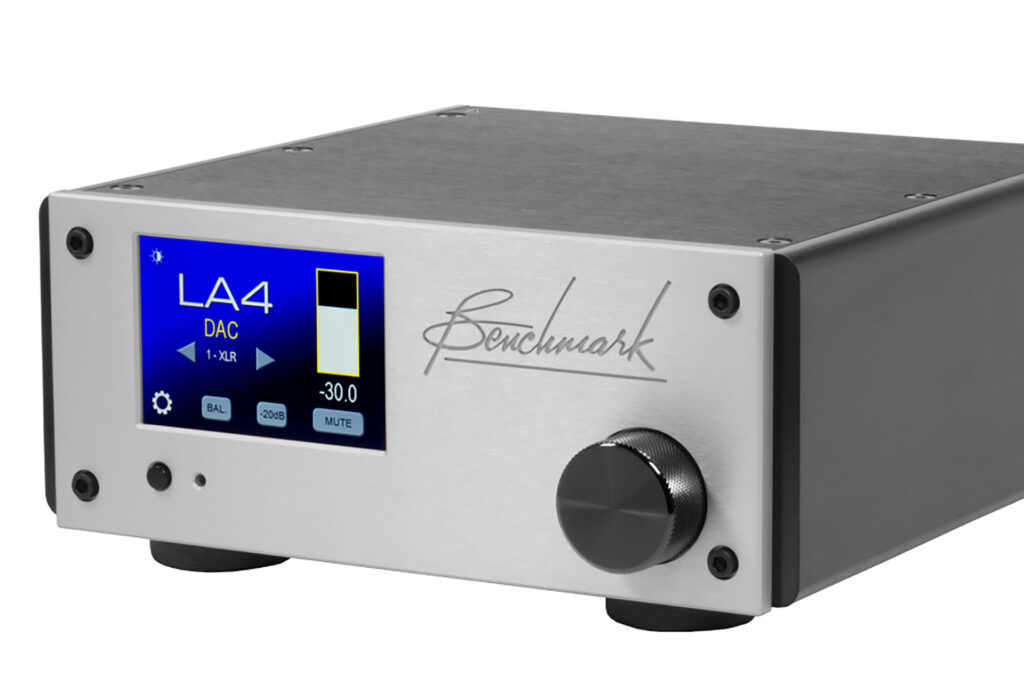
What is the Competition for the Benchmark LA4 Preamplifier?
One obvious option is the Benchmark HPA4 ($3,599 with remote), essentially an LA4 with headphone amplifier added. Via headphones, the low noise of the Benchmark preamp should be even more compelling, so that audiophiles who own headphones may decide that the HPA4 is worth the small premium.
When publisher Jerry Del Colliano reviewed the PS Audio Stellar Gold Preamp ($3,999), he was especially impressed by its transparency. As an analog line-level preamplifier, it’s similar in functionality to the Benchmark LA4, though more costly, and it would be a fine addition to the audition list of someone wanting a simple, well-built, transparent preamp.
Audiophiles who want digital room correction might consider the Anthem STR Preamplifier (read review), the reference preamp of three of our reviewers, including me. The Anthem STR offers a lot for $4,299.99, including great looks, an excellent user interface, built-in DAC, room correction, tone controls, and digital crossovers. Although it’s not apparent to me on most music, the critical listener may find that the Anthem’s transparency is a bit less than the Benchmark’s, and that the Anthem’s treble can sound slightly less pure on some material. It’s a dilemma – useful sonic features vs. more transparent sound – and each audiophile will have to navigate it for themselves.
If you are inclined to try a product from a Chinese maker (see our article on Chi-Fi on the plusses and minuses of that approach), the Topping A90 Discrete ($599) impressed reviewer Steven Stone. It includes headphone and preamp outputs, and its measurements rival the Benchmark LA4, though its display is not as good. To get more than one input requires adding Topping’s EXT90 Input Extender ($249). I have only brief experience with Topping products, but at the price, I would not expect the same attention to user’s manuals, quality control, packaging, or long-term support as I take for granted from Benchmark.
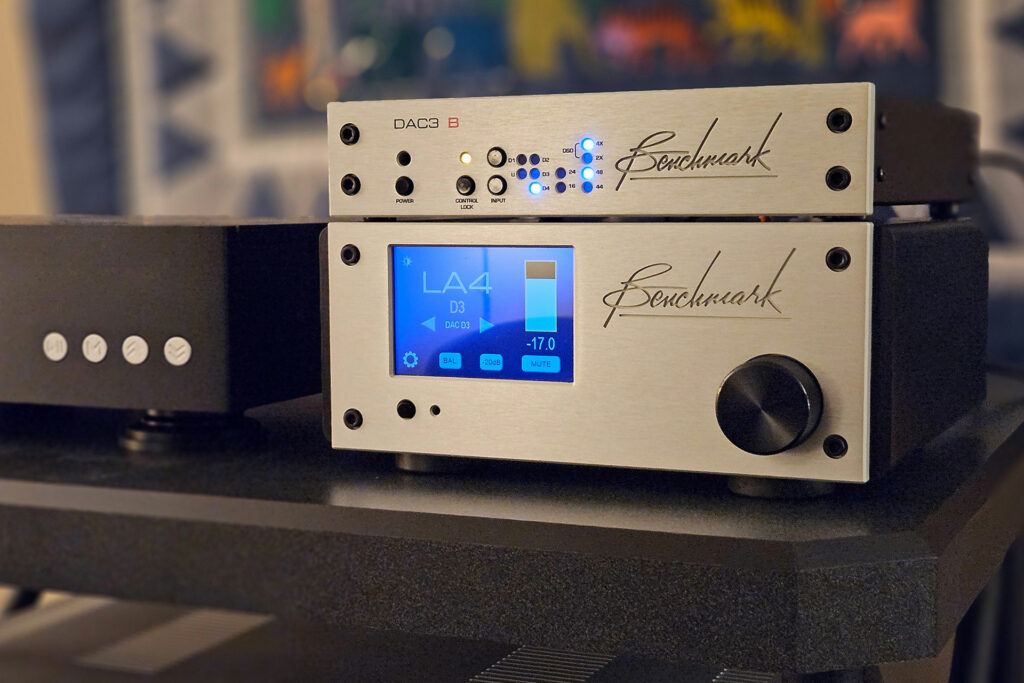
Final Thoughts on the Benchmark LA4 Preamplifier …
I was swept away by the musical transparency of the Benchmark LA4, by its freedom from high-frequency distortion, and by the increased engagement those qualities allowed. This was especially true in music like Mozart’s string quartets, in which a few bowed string instruments play fully exposed, and any added harshness is all too plain. With the Benchmark LA4 preamp, there was no added harshness, and I enjoyed the music tremendously. In everything I played through the Benchmark LA4, textures and nuances of voices and instruments came through superbly, making each voice or instrument seem more individual and less generic. That kind of transparency is, musically speaking, a remarkable accomplishment.
I consider the Benchmark LA4 a leader in its category, especially at its price. For the audiophile who wants true high fidelity, it offers state-of-the-art performance at a reasonable price. If you don’t need extra features, but want an audiophile preamplifier with outstanding transparency, neutrality, and dynamic, engaging sound, the Benchmark LA4 preamp should be way, way up on your audition list.




I’ve owned the sister preamp with headphone provisions, the HPA4. Accuracy and transparency vs. warm and forgiveness. I still want the Holo Audio Serene, but I have no complaints with this preamp and it is every bit as transparent to source as Mike states.
The silver is nice, but I think I would’ve liked the black faceplate more. Vanta-black darkness with a high contrast screen has a certain appeal.
Thanks for your comments, Jeff. Glad to hear you are enjoying the HPA4.
Hi guys, I love you your reviews, since you reviewed both the Benchmark LA4 and the SPL Elector (and the Director Mk2 as preamp) I would love to know which preamp, in your opinion, is better? I am torn between these two for my active ATC speakers. Thank you, Les
A choice between the Benchmark and the SPL, in my opinion, would be more based on features than sound quality, as both are excellent sonically. If you need a tape loop (say for an equalizer) or you switch to mono frequently, the SPL might be your choice. If you want precisely repeatable volume settings, the Benchmark would be superior. The Benchmark can provide more gain than the SPL, helpful in some systems, not needed in others. If you use headphones, you can get the Benchmark HPA4 (essentially the LA4 with headphone amp added) for about $550 more.
Then there are intangibles to consider. Does the factory’s being in the USA matter to you? How about appearance? Some find the Benchmark rather plain, and the SPL more attractive, with its meters and optional red finish.
It’s pretty great to have a choice of two excellent preamps at reasonable prices.
I’ve owned BOTH recently.
Both are PRO Audio components thus very resolved which I LOVE. Not all audiophiles do but they should, I think. 🙂
You simply can’t go wrong with either. I didn’t. You won’t. 🙂
Jerry